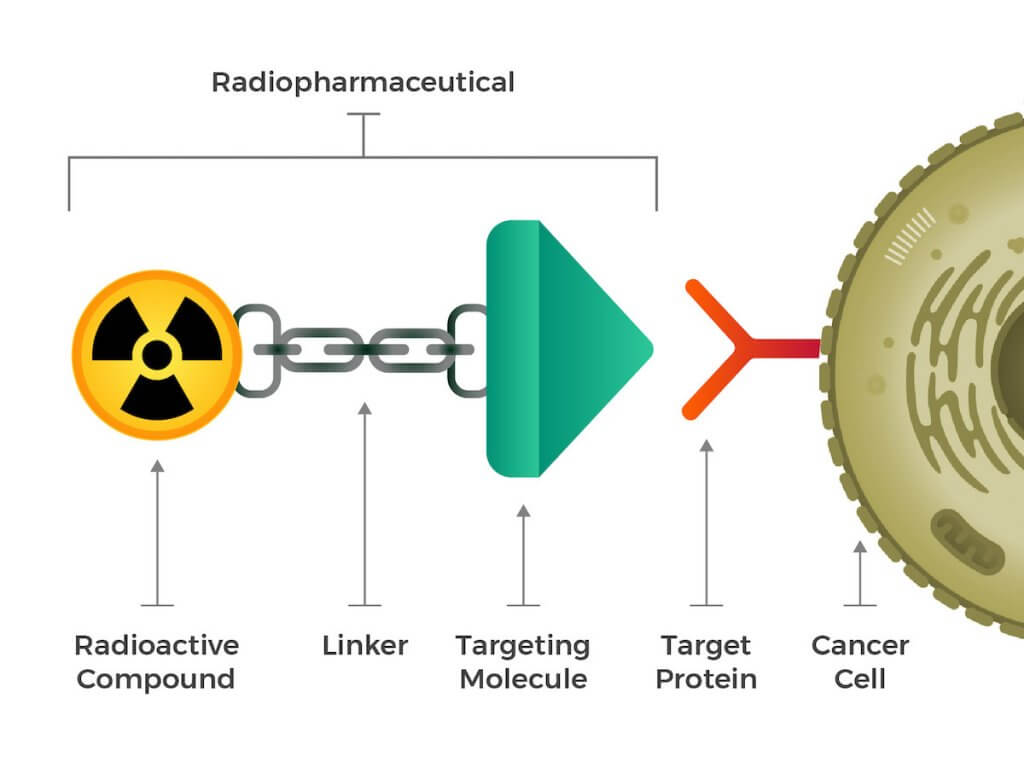Key Takeaways:
- Radiopharmaceuticals can be used to diagnose and treat certain types of cancer.
- Researchers are increasingly interested in the potential of radiopharmaceutical agents to target more types of cancer.
Drugs that contain radioactive isotopes — forms of chemical elements that emit radiation — are known as radiopharmaceuticals. Radioisotopes have been used to treat cancer as far back as the 1940s, but the field has really taken off just in the past few years as researchers explore their potential in cancer.
How are radiopharmaceuticals used in cancer today?
Because they give off carefully controlled amounts of radiation, radiopharmaceuticals can be injected into the body and viewed with imaging devices as they bind to specific molecules on the surface of cancer cells to aid in a cancer diagnosis.
Radiopharmaceuticals are also being developed to deliver cell-killing doses of radiation directly to cancer cells within the body.

In 2013, a drug known as Xofigo, or radium 223 dichloride, was approved to treat metastatic prostate cancer that has spread to the bones. Radium 223 dichloride is absorbed into the bones, and the radiation it emits kills cancers cells there. It does not cure cancer, but helps to shrink bone metastases and relieve bone pain and may help people with metastatic prostate cancer live longer.
Current efforts are focused on radioisotopes that are linked to antibodies, peptides (building blocks of proteins), or small molecules that target specific proteins expressed on the surface of tumor cells, but not on normal cells. In 2018 the drug lutetium Lu 177-dotatate, or Lutathera, was approved to treat certain cancerous neuroendocrine tumors affecting the digestive tract. The drug’s approval was hailed as a big step forward in the field: It showed that solid tumors could be effectively targeted with cell-killing radiation from radioisotope linked to peptides that latched onto a cancer-specific target on tumor cells.
Another radiopharmaceutical drug, Lobenguane iodine-131 or Azedra, is approved to treat adrenal gland tumors.
There is “an explosion of companies that are looking at different radiopharmaceutical agents targeting cancer,” says Heather Jacene, MD, clinical director of nuclear medicine at Dana-Farber.
What’s the latest research in radiopharmaceuticals?
At the June 2021 meeting of the American Society of Clinical Oncology, researchers presented the results of a clinical trial of a Novartis radiopharmaceutical that delivers radiation to prostate cancer cells. The radioisotope is linked to a small molecule that targets a protein found on most prostate cancer cells. The report said the drug, administered to men with metastatic, castration-resistant prostate cancer, reduced the risk of death by 38% compared with standard drugs and reduced the risk of tumor progression by 60%
Mary-Ellen Taplin, MD, a prostate cancer specialist at Dana-Farber, noted that the benefits were only incremental, averaging about four months’ longer survival compared with standard drugs. Novartis is preparing to test the drug in men with earlier stages of prostate cancer, in hopes of showing a greater survival benefit.
“It is impressive therapy,” says Taplin. “For one thing, it is a targeted therapy, and I am thrilled to have another option for patients who need other treatments.”
Patients may naturally be concerned about the safety of having radioactive substances administered to them. But the scientific evidence indicates that the risks associated with exposure to diagnostic nuclear medicine are minimal, and use of radiopharmaceutical tracers often eliminates the need for invasive procedures or surgery. The risks associated with therapeutic nuclear medicine are higher, but the benefits are potentially lifesaving, say researchers.
Treatment with radiopharmaceuticals requires teamwork, including nuclear medicine experts like Jacene, and rooms equipped for administering therapeutic radiopharmaceuticals to protect the staff; Dana-Farber has one at its main campus and a two-room suite at its Chestnut Hill facility.

Have radiopharmaceutical agents shown any promise in treating brain cancers, specifically, astrocytoma/glioblastoma?
Hi Mary and Solon,
The potential for radiopharmaceuticals being used in these diseases is unknown because trials are at a very early stage. Information about clinical trials can always be found here: https://www.dana-farber.org/research/clinical-trials/
Wishing you all the best,
DFCI
Is there any studies for Multiple Myeloma?
I had PRRT – Lutethera Dotatate therapy four times throughout 2020 and it worked very well for me. It arrested the growth of more neuroendocrine cancer cells in my liver and abdominal cavity. It was definitely worth having this life-changing therapy!